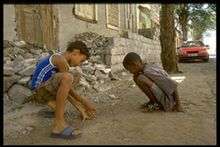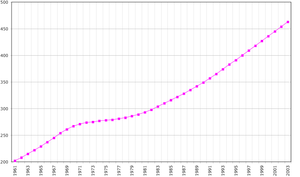Demographics of Cape Verde

This article is about the demographic features of the population of Cape Verde, including population density, ethnicity, education level, health of the populace, economic status, religious affiliations and other aspects of the population.
Cape Verde has a population of about 540000 inhabitants, divided evenly of those who live in the islands and the ones who live abroad in the Cape Verdean diaspora in mainland Africa, Europe, U.S., Brazil, et cetera. A large proportion (236,000) of Cape Verdeans live on the main island, Santiago.[1]
The archipelago of Cape Verde were first found and claimed by Portuguese sailors working for the Portuguese Crown in 1456. Subsequently, enslaved Africans and Portuguese convicts were brought to the islands to work as agricultural field hands. As a result of the intermingling and genetic liaison of the said populations, some of the present day Cape Verdeans are considered mulattoes, who have mixed black and white origins. European ancestors also include Spanish, Italian and French seamen who were granted land by the Portuguese Empire, followed by Portuguese settlers, exiles, and Portuguese Jews who were victims of the Inquisition yet perpetrated slavery. Many foreigners from other parts of the world settled in Cape Verde as their permanent country. Most of them were Dutch, French, British (English), Arab and Jewish (from Lebanon and Morocco). All of these have been absorbed into the mixed population.
The high degree of genetic mixture of individuals is a result of centuries of migration. It is not unusual to encounter persons with dark skin, blond hair, and blue eyes, and persons with seemingly light caucasian skin and textured curly hair.
Survival in a country with few natural resources has historically induced Cape Verdeans to emigrate. In fact, of the more than 1 million people of Cape Verdean ancestry in the world, only a little more than one-third actually live on the islands. Some 500,000 people of Cape Verdean ancestry live in the United States, mainly in New England. Many people of Cape Verdean ancestry also live in Portugal, Netherlands, France, Italy, Mexico, Uruguay, Argentina, and Senegal. Cape Verdean populations also settled Spain, Germany, Canada, and other CPLP countries (Angola, Brazil and Guinea-Bissau). Since after independence from Portugal in 1975, a number of Cape Verdean students continued to be admitted every year at Portuguese high schools, polytechnical institutes and universities, through bilateral agreements between the Portuguese and Cape Verdean governments.
Portuguese functions as a state language. Virtually all formal documents and official declarations are stated in Portuguese. But it is not the first language. Cape Verdean, commonly called Creolo, is spoken as a mother tongue by virtually all Cape Verdeans, irrespective of social status or religious affiliation. Moreover, historical linguists often attribute Cape Verdean Creole as the oldest "New World" contact language. It is a "contact" language in the sense that it was birthed and evolved between linguistically different groups who, by necessity, had to create a common language to communicate with each other. There is a rich repertoire of literature and songs in Cape Verdean Creole. In religion, the majority of Cape Verdeans follow Catholic Christianity. There are some Protestants, Bahá'ís and Muslims.
Population

According to the 2017 revision of the World Population Prospects[2] the total population was 539,560 in 2016, compared to only 178 000 in 1950. The proportion of children below the age of 15 in 2010 was 31.8%, 62.3% was between 15 and 65 years of age, while 5.9% was 65 years or older.[3]
| Total population | Population aged 0–14 (%) | Population aged 15–64 (%) | Population aged 65+ (%) | |
|---|---|---|---|---|
| 1950 | 178 000 | 32.6 | 59.8 | 7.6 |
| 1955 | 195 000 | 35.8 | 57.9 | 6.2 |
| 1960 | 211 000 | 42.1 | 53.2 | 4.8 |
| 1965 | 240 000 | 48.5 | 47.3 | 4.2 |
| 1970 | 274 000 | 48.2 | 47.8 | 4 |
| 1975 | 311 000 | 45.8 | 49.6 | 4.6 |
| 1980 | 300 000 | 46 | 48.7 | 5.3 |
| 1985 | 328 000 | 44.5 | 50.5 | 5 |
| 1990 | 348 000 | 45.4 | 49.8 | 4.8 |
| 1995 | 395 000 | 44.5 | 50.5 | 5 |
| 2000 | 437 000 | 41.7 | 52.9 | 5.3 |
| 2005 | 473 000 | 37 | 57.2 | 5.8 |
| 2010 | 496 000 | 31.8 | 62.3 | 5.9 |
Vital statistics
Vital events of Cape Verde are not (yet) available for recent years. The Population Department of the United Nations prepared the following estimates.[3]
| Period | Live births per year | Deaths per year | Natural change per year | CBR* | CDR* | NC* | TFR* | IMR* |
|---|---|---|---|---|---|---|---|---|
| 1950-1955 | 9 000 | 4 000 | 5 000 | 49.0 | 22.6 | 26.3 | 6.57 | 139 |
| 1955-1960 | 10 000 | 4 000 | 5 000 | 48.0 | 21.1 | 26.9 | 6.76 | 132 |
| 1960-1965 | 10 000 | 4 000 | 6 000 | 45.0 | 18.7 | 26.3 | 6.97 | 125 |
| 1965-1970 | 11 000 | 4 000 | 6 000 | 41.4 | 16.4 | 25.0 | 6.97 | 117 |
| 1970-1975 | 12 000 | 4 000 | 8 000 | 41.1 | 13.4 | 27.7 | 6.86 | 96 |
| 1975-1980 | 13 000 | 4 000 | 9 000 | 41.6 | 11.6 | 30.0 | 6.62 | 78 |
| 1980-1985 | 13 000 | 3 000 | 10 000 | 41.3 | 10.3 | 31.0 | 6.10 | 65 |
| 1985-1990 | 14 000 | 3 000 | 11 000 | 40.9 | 9.2 | 31.7 | 5.63 | 54 |
| 1990-1995 | 14 000 | 3 000 | 11 000 | 36.5 | 7.9 | 28.6 | 4.93 | 44 |
| 1995-2000 | 13 000 | 3 000 | 10 000 | 31.6 | 6.7 | 24.9 | 4.15 | 37 |
| 2000-2005 | 12 000 | 3 000 | 9 000 | 26.2 | 5.8 | 20.5 | 3.28 | 28 |
| 2005-2010 | 11 000 | 3 000 | 8 000 | 21.9 | 5.2 | 16.7 | 2.60 | 21 |
| * CBR = crude birth rate (per 1000); CDR = crude death rate (per 1000); NC = natural change (per 1000); IMR = infant mortality rate per 1000 births; TFR = total fertility rate (number of children per woman) | ||||||||
Births and deaths[4]
| Year | Population (x1000) | Live births | Deaths | Natural increase | Crude birth rate | Crude death rate | Rate of natural increase | TFR |
|---|---|---|---|---|---|---|---|---|
| 2009 | 13 044 | 2 897 | 10 147 | 25,6 | 5,7 | 19,9 | ||
| 2010 | 13 415 | 2 917 | 10 498 | 25,9 | 5,6 | 20,3 | ||
Fertility and births
Total fertility rate (TFR) (wanted fertility rate) and crude birth rate (CBR):[5]
| Year | CBR (Total) | TFR (Total) | CBR (Urban) | TFR (Urban) | CBR (Rural) | TFR (Rural) |
|---|---|---|---|---|---|---|
| 2005 | 22 | 2,9 (2,8) | 23 | 2,7 (2,7) | 22 | 3,1 (3,0) |
Fertility data from 2005 (DHS Program):[6]
| Region | Total fertility rate | Percentage of women age 15-49 currently pregnant | Mean number of children ever born to women age 40-49 |
|---|---|---|---|
| Santo Antão | 2.9 | 3.8 | 6.0 |
| São Vicente | 2.0 | 3.4 | 4.0 |
| São Nicolau | 3.3 | 4.4 | 4.2 |
| Sal | 3.2 | 7.0 | 3.9 |
| Boa Vista | 2.4 | 10.0 | 4.4 |
| Maio | 2.6 | 1.7 | 4.3 |
| Santiago | 3.1 | 5.4 | 4.5 |
| Praia Urbano | 3.2 | 5.1 | 4.5 |
| Santiago Norte | 2.7 | 6.2 | 4.3 |
| Resto Santiago | 3.3 | 4.6 | 4.8 |
| Fogo | 3.1 | 6.3 | 5.6 |
| Brava | 2.8 | 7.0 | 5.0 |
Life expectancy
| Period | Life expectancy in Years[7] |
|---|---|
| 1950–1955 | 48.08 |
| 1955–1960 | |
| 1960–1965 | |
| 1965–1970 | |
| 1970–1975 | |
| 1975–1980 | |
| 1980–1985 | |
| 1985–1990 | |
| 1990–1995 | |
| 1995–2000 | |
| 2000–2005 | |
| 2005–2010 | |
| 2010–2015 |
CIA World Factbook demographic statistics
The following demographic statistics are from the CIA World Factbook, unless otherwise indicated.
Median age
- Total: 23.1 years
- Male: 22.3 years
- Female: 23.9 years (2012 est.)
Urbanization
- Urban population: 60% of total population (2008)
- Rate of urbanization: 3.5% annual rate of change (2005-10 est.)
Sex ratio
- At birth: 1.03 male(s)/female
- Under 15 years: 1.01 male(s)/female
- 15-64 years: 0.97 male(s)/female
- 65 years and over: 0.58 male(s)/female
- Total population: 0.95 male(s)/female (2009 est.)
Life expectancy at birth
- Total population: 71 years
- Male: 68.78 years
- Female: 73.27 years (2012 est.)
HIV/AIDS
- Adult prevalence rate: 0.035% (2001 est.)
- People living with HIV/AIDS: 775 (2001)
- Deaths: 225 (as of 2001)
Genetics
- The predominance of west African mitochondrial DNA haplotypes in their maternal gene pool, the major west African Y-chromosome lineage E3a was observed only at a frequency of 15.9%. Overall, these results indicate that gene flow from multiple sources and sex-specific patterns have been important in the formation of the genomic diversity in the Cabo Verde islands.[8]
Ethnic groups
Religions
- Catholic 77.3%, Protestant 3.7% (includes Church of the Nazarene 1.7%, Adventist 1.5%, Universal Kingdom of God 0.4%, and God and Love 0.1%), other Christian 4.3% (includes Christian Rationalism 1.9%, Jehovah's Witness 1%, Assembly of God 0.9%, and New Apostolic 0.5%), Islam 1.8%, Other 1.3%, None 10.8%, Unspecified 0.7% [9]
Languages
- Portuguese (official), Crioulo (a blend of Portuguese and West African words)[9]
Literacy
- Definition: age 15 and over can read and write
- Total population: 76.6%
- Male: 85.8%
- Female: 69.2% (2003 est.)
See also
References
- ↑ "Cape Verde: Population". Caperverde.com. Retrieved 3 October 2017.
- ↑ "World Population Prospects: The 2017 Revision". ESA.UN.org (custom data acquired via website). United Nations Department of Economic and Social Affairs, Population Division. Retrieved 10 September 2017.
- 1 2 "Population Division of the Department of Economic and Social Affairs of the United Nations Secretariat, World Population Prospects: The 2010 Revision". Esa.un.org. Retrieved 3 October 2017.
- ↑ "United Nations Statistics Division - Demographic and Social Statistics". unstats.un.org. Retrieved 3 October 2017.
- ↑ "Server Error". microdata.worldbank.org. Retrieved 3 October 2017.
- ↑ "Inquérito Demográfico e de Saúde Reprodutiva (IDSR-II)" (PDF). Dhsprogram.com. 2005. Retrieved 2 October 2017.
- ↑ "World Population Prospects - Population Division - United Nations". esa.un.org. Retrieved 2018-08-26.
- ↑ Gonçalves, Rita; Alexandra Rosa; Ana Freitas; Ana Fernandes; Toomas Kivisild; Richard Villems; António Brehm (26 August 2003). "Y-chromosome lineages in Cabo Verde Islands witness the diverse geographic origin of its first male settlers". Human Genetics. 113 (6): 467–472. doi:10.1007/s00439-003-1007-4. PMID 12942365.
- 1 2 3 "Africa :: CAPE VERDE". CIA The World Factbook.
![]()
External links
| Wikimedia Commons has media related to Demographics of Cape Verde. |
- National Institute of Statistics
- Demographic Highlights — Statistics from the Population Reference Bureau